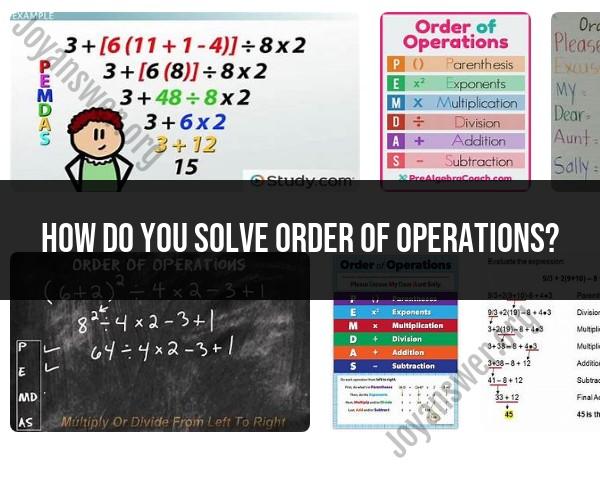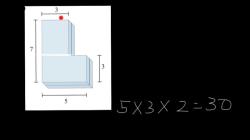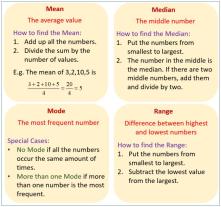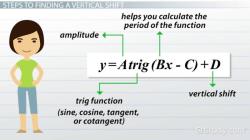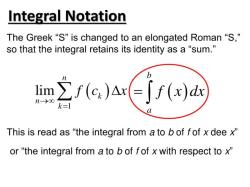How do you solve Order of operations?
Solving problems using the order of operations involves following a specific sequence of mathematical rules to simplify expressions or equations correctly. The standard order of operations is often remembered using the acronym PEMDAS, which stands for:
- P: Parentheses
- E: Exponents
- MD: Multiplication and Division (from left to right)
- AS: Addition and Subtraction (from left to right)
To solve problems using the order of operations, follow these steps:
Start with Parentheses: Evaluate expressions inside parentheses first. Work from the innermost set of parentheses outward. If there are nested parentheses, resolve the innermost set first.
Exponents: Once you have simplified all the expressions within parentheses, evaluate any expressions with exponents (powers and roots).
Multiplication and Division: Perform multiplication and division from left to right as they appear in the expression. These two operations have the same level of precedence, so execute them in the order in which they are encountered.
Addition and Subtraction: Finally, perform addition and subtraction from left to right, as they appear in the expression. Like multiplication and division, addition and subtraction have the same level of precedence, so work from left to right.
Here's an example to illustrate the process:
Expression: 4 + 3 × (2^2 - 1)
- Inside the parentheses: 2^2 - 1 = 4 - 1 = 3
- Exponents: 4 + 3 × 3
- Multiplication: 4 + 9
- Addition: 13
So, the expression simplifies to 13 by following the order of operations (PEMDAS).
Remember, correctly following the order of operations ensures that mathematical expressions are evaluated consistently and accurately. Using parentheses when needed to clarify the sequence of operations is essential to avoid ambiguity.
What are the fundamental principles of the order of operations in mathematics?
The order of operations is a set of rules that define the order in which operations are performed in an mathematical expression. The order of operations is important because it ensures that all expressions are evaluated in the same way and that the same result is obtained regardless of the order in which the operations are performed.
The fundamental principles of the order of operations are as follows:
- Grouping symbols: All operations within parentheses, brackets, and braces are performed first, from the innermost set of parentheses to the outermost set.
- Exponents: Exponents are evaluated next, from left to right.
- Multiplication and division: Multiplication and division are performed next, from left to right.
- Addition and subtraction: Addition and subtraction are performed last, from left to right.
How do you solve mathematical expressions by following the order of operations?
To solve a mathematical expression by following the order of operations, you simply perform the operations in the order specified by the order of operations. For example, to solve the expression 2 + 3 × 5, you would first perform the multiplication operation inside the parentheses, resulting in 2 + 15. Then, you would perform the addition operation, resulting in the final answer of 17.
Here are some additional examples of how to solve mathematical expressions by following the order of operations:
(2 + 3) × 5 = 5 × 5 = 252^3 + 4 × 5 = 8 + 4 × 5 = 8 + 20 = 28(2 + 3) / 5 = 5 / 5 = 1
Are there common mistakes to avoid when working with the order of operations?
One common mistake to avoid when working with the order of operations is to assume that all operations are performed from left to right. Instead, you should always follow the order of operations, which gives priority to grouping symbols, exponents, multiplication and division, and then addition and subtraction.
Another common mistake is to forget to evaluate exponents before performing multiplication and division. Exponents are always evaluated first, even if they appear after a multiplication or division sign.
What are some real-world applications of the order of operations?
The order of operations is used in a wide variety of real-world applications, including:
- Engineering: Engineers use the order of operations to design and build bridges, buildings, and other structures.
- Science: Scientists use the order of operations to conduct experiments and analyze data.
- Finance: Financial professionals use the order of operations to calculate interest rates, loan payments, and other financial metrics.
- Everyday life: We all use the order of operations in our everyday lives, even if we don't realize it. For example, when we follow a recipe, we are essentially following a set of instructions that describe the steps involved in preparing the dish in the correct order.
How does the order of operations relate to algebraic expressions and equations?
The order of operations is also used in algebraic expressions and equations. For example, the expression 2x + 3y + 4 is evaluated using the order of operations. First, the multiplication operations are performed, resulting in 2x + 3y + 4. Then, the addition operation is performed, resulting in the final answer of 2x + 3y + 4.
Algebraic equations are also solved using the order of operations. For example, to solve the equation 2x + 3 = 5, we would first subtract 3 from both sides of the equation, resulting in 2x = 2. Then, we would divide both sides of the equation by 2, resulting in the final answer of x = 1.
